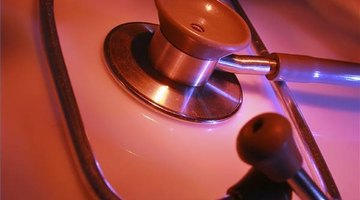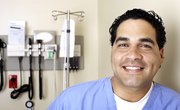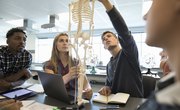Medical terminology is the words or language used by health care professionals to identify anatomical structures, diagnoses, instruments, procedures, protocols and medications. When you first encounter medical terminology, it may seem overwhelming and hard to comprehend. However, there are a number of exercises you can use to become better acquainted with the language
Understanding Word Components and Origins
Since medical terminology is rooted in Greek and Latin, it's important to familiarize yourself with a few basic components of the languages. This includes the way medical terms are formed and their components. Identifying the word root (generally located in the middle), prefix (before the word root), suffix (found at the end of the word) and combining form will provide you with a solid foundation. For example, let's break apart the term myocarditis. The word root is cardio (heart), the prefix is my/mys (muscle), the suffix is itis (inflammation), and the combining form is the letter "o." As you can see, the term's structural components are added together to inform us of the definition. Hence the medical term myocarditis indicates a condition in which the muscle layer of the heart is inflamed. As an exercise, take a stack of index cards and divide them into four piles: word roots, prefixes, suffixes and combining forms. Write down a variety of words for each category. Start by using common root words like acr (extremity), cardio (heart) and gastr (stomach). Add prefixes, such as endo (within), trans (across), para (beside) and dys (difficult). Suffixes include megaly (enlargement of the heart) and ologist (a physician specializing in the heart). The combining form is "o." Rearrange the combinations of the cards (keep switching the various prefixes and suffixes around) to construct, evaluate, spell and pronounce assorted medical words. In addition to learning the formations, this exercise will illustrate how the meanings of terms alter significantly when the parts are changed around.
Anatomy and Physiology
Once you're familiar with the above, it's a good idea to dive into basic human anatomy and physiology (a major part of medical terminology). This includes body structure and functions; cells, tissues and membranes; and all of the systems: skeletal, muscular, nervous; endocrine, cardiovascular, lymphatic, respiratory, digestive, urinary and reproductive.
Before concerning yourself with the medical terms used to indicate specific systems of the body, you'll want to focus on those word roots, which name the body's major organs. For example, take the word roots: cardio, colo, cysto, dento, dermo, entero, encephalo, gastro, gingivo, hemo, hepato, hystero, masto/mammo, osteo, phlebo/veno, pneumo/pulmo, procto and rhino. Chances are, you've encountered many of these words before and can make out their definitions. Now, take the above word roots and add the different prefixes and suffixes that you learned in the previous exercise. If you have a chalkboard, or dry erase board (poster board or construction paper will do as well) draw five lines down the page and then mark additional lines through those to create a graph of sorts. Fill the first row of boxes going down with prefixes, the next boxes going down with word roots and the third with suffixes. In the fourth row, write down a medical term that's made up of the parts from the boxes to the left. For example, diagonally it may read: peri/card/itis/pericarditis. Use the last row to write down the meaning.
Additional Exercises
Becoming proficient in medical terminology is exactly like learning any other new language. It takes practice, patience and time. In addition to the flash cards and above exercises, numerous websites offer study guides, free practice quizzes, assessments and other materials (see Resources). Fun activities like crossword puzzles, fill in the blanks and online labeling games can help you to further grasp the ins-and-outs of medical terminology. Furthermore, reviewing medical documents (patient records, discharge summaries, surgical reports) can also help illustrate the way the terms are seen within their medical context. Printing out a poster of the human body and labeling the parts using word roots, will provide a more visual illustration for your learning.
Related Articles
References
Writer Bio
Serena Spinello holds two master’s degrees and is pursuing her Ph.D. in medical science. She has been a professional writer and researcher for over 10 years and is an active member of the American Medical Writers Association, Academy of Medical Educators, and the National Association of Social Workers.










